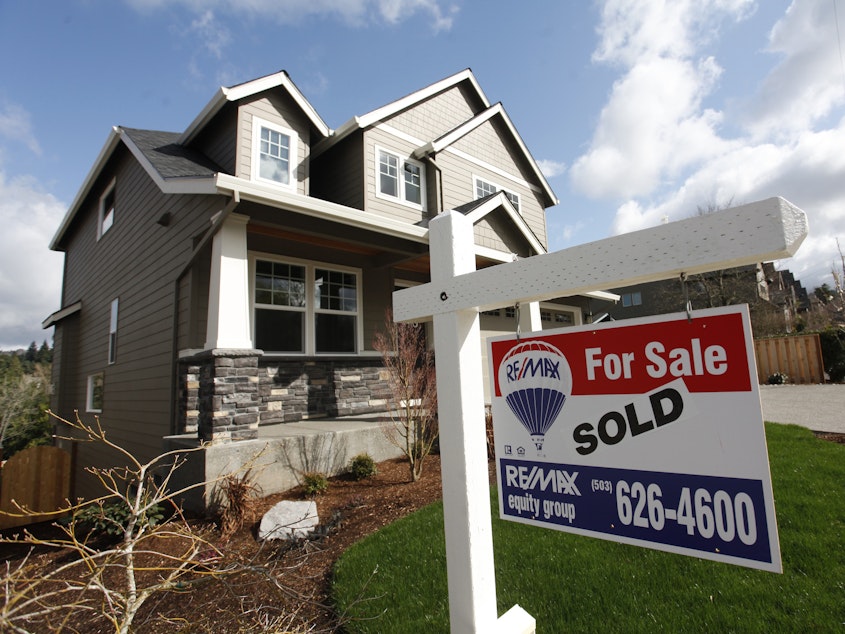Mortgage Rates Are Near All-Time Lows As Coronavirus Worries Hit Markets

A dramatic drop in mortgage rates may give prospective homebuyers a chance to afford the house they've been eyeing — or to lower monthly payments for homeowners who refinance.
Last week, fears over coronavirus outbreak's anticipated economic impact sparked the most dramatic stock market sell-off since the financial crisis. Stocks rallied Monday on expectations that the Federal Reserve will cut interest rates to boost the economy.
But there's a silver lining in this market mayhem for homeowners and homebuyers: Mortgage rates have been driven down near all-time lows.
Don't see the graphic above? Click here.
Mortgages tend to rise and fall with 10-year Treasury yields. So nervous investors piling into bonds have helped push down mortgage rates, which have fallen about a full percentage point over the past year.
Sponsored
That's a good thing, says Laurie Goodman, co-director of the Housing Finance Policy Center at the Urban Institute. She says buying a home is crucial for most Americans to build wealth and these lower rates can mean hundreds or thousands of dollars a year in lower mortgage payments.
"Homeownership is really the single best way to build wealth," Goodman says. The median homeowner has a net worth of around $230,000 — nearly half of that is in the form of equity in their home, she says. Meanwhile, Goodman adds, the median renter has a total wealth of less than $5,000.
If you have good credit, rates on a 30-year fixed mortgage have dropped from about 4.5% to around 3.5% over the past year. Goodman says that effectively makes the same priced house from a year ago more than 10% cheaper today in monthly mortgage payments.
So, she says, someone who was on the fence a year ago about whether they could afford to own a home "is going to find it very attractive at this time."
Millions of people around the country who are already homeowners could probably save money on their monthly payment by refinancing. But, it can be a little tricky to figure out if that's worth doing.
Sponsored
Elysia Stobbe works in the mortgage industry and is the author of the book How To Get Approved For The Best Mortgage Without Sticking A Fork In Your Eye.
"People see rates are low, or rates are dropping, so we get a lot of calls," she says. "People just want us to run the numbers and make sure it makes sense."
Stobbe says on a $300,000 30-year fixed rate loan, if you were at 4.5% and refinanced at 3.5%, that would save you about $2,000 a year in mortgage payments. So that sounds pretty good.
"Yes, the monthly savings is great," she says, "but what are the fees involved?"
Stobbe says the fees vary a lot from state to state. In Florida, you might have to pay thousands of dollars more than in Virginia or Georgia, she says. So she says you want to think about how long it will take to break even on paying those fees before you actually save any money.
Sponsored
And there's one last very important thing to consider — especially if you've been paying your mortgage for a long time, say five or 10 years. When you get a new 30-year loan, you go back to year one on your payments. That matters a lot because in those early years you're paying much more interest than you are principal. So you're not paying down what you owe on the house that much.
"Absolutely," Stobbe says, "on any loan, the interest is front-loaded."
Think about this like eating a sandwich. The mayonnaise is the interest you pay the bank. The meat is the principal — the amount that goes toward building equity and actually owning more of your home.
The first couple years on a new 30-year loan, you're basically eating a mayonnaise sandwich. It's mostly interest. So you probably don't want to go back there.
Stobbe says many lenders will structure a 25-year or 20-year loan so you don't have to go all the way back to square one. And if you can afford to refinance into a 15-year loan, she says that's even better. "The shorter term, you're plugging away at that principal much quicker than the longer 30-year fixed," Stobbe says. [Copyright 2020 NPR]



